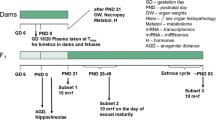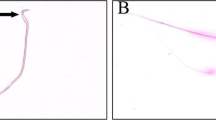Abstract
Diethylstilbestrol (DES) at 0.019–0.025 mg/g body weight, fed with grain baits to Levante voles (Microtus guentheri [D. & A.]) of different age, sex and physiological condition, suppressed gestation for the first 10 days after mating. These doses, which are consumed voluntarily, also caused sterility in daughters of females which received DES at the end of pregnancy, and sterility or a significant delay (2–3 months) in sexual maturity of females which received it in their mother’s milk during the first days of life. DES had no significant effect on adult nonpregnant females or on males of any age, even if administered 3 days before mating.
Similar content being viewed by others
References
Allen, M.J. (1941) The lack of inactivation of stilbestrol by the liver.Am. J. Physiol. 133: 194.
Balser, D.S. (1964) Management of predator populations with antifertility agents.J. Wildl. Mgmt 28: 352–358.
Bodenheimer, F.S. (1949) Problems of vole populations in the Middle East. Report on the population dynamics of the Levante vole (Microtus guentheri D. et A.). The Research Council of Israel, Jerusalem.
Bodenheimer, F.S. (1959) A biologist in Israel. Biological Studies Publishers, Jerusalem.
Burrows, H. (1949) Biological Actions of Sex Hormones. 2nd ed. Cambridge University Press, Cambridge, U.K.
Dodds, E.S., Goldberg, L., Lawson, W. and Robinson, R. (1938) Oestrogenic activity of certain synthetic compounds.Nature, Lond. 141: 247–248.
Giliwicz, J., Andrzejewski, R., Bujalska, G. and Petrusewicz, K. (1968) Productivity investigation of an island population ofClethrionomys glareolus (Schreber, 1780). I. Dynamics of cohorts.Acta theriol. 13: 401–413.
Godfrey, M.E. (1977) Techniques for the evaluation of potential rabbit (Oryctolagus cuniculus) chemosterilants.in: Jackson, W.B. and Marsh, R.E. [Eds.] Test Methods for Vertebrate Pest Control and Management Materials. ASTM STP 625, pp. 99–105. American Society for Testing and Materials, Philadelphia, PA.
Goulet, E.A. and Sadleir, R.M.F.S. (1974) The effects of a chemosterilant (mestranol) on population and behavior in the Richardson’s ground squirrel (Spermophilus richardsoni) in Alberta.Proc. Vertebrate Pest Control Conf., Univ. of California, Davis.6: 90–100.
Greene, R.R., Burrell, M.W. and Ivy, A.C., (1938) Experimental intersexuality: the reproduction of feminized male rats by antenatal treatment with estrogens.Science, N.Y. 88: 130–131.
Johnson, M.A. (1974) A probablistic analysis of a class of male rat chemosterilants.Biometrics 30: 341–353.
Howard, W.E. and Marsh, R.E. (1969) Mestranol as a reproductive inhibitor in rats and voles.J. Wildl. Mgmt 33: 403–408.
Kennelly, J.E., Johus, B.E. and Garrison, M.V. (1972) Influence of sterile males on fecundity of a rat colony.J. Wildl. Mgmt 36: 161–165.
Lindsey, C.D., Anthony, R.M. and Evans, J. (1974) Mestranol as a repellent to protect Douglas-fir seed from deer mice.Proc. Vertebrate Pest Control Conf., Univ. of California, Davis.6: 272–279.
Linhart, S.B., Brusman, H.H. and Balser, D.S. (1968) Field evaluation of an antifertility agent, stilbestrol, for inhibiting coyote reproduction.Trans. 33rd North American Wildlife and Natural Resources Conf., Wildlife Management Institute, Wash., D.C. pp. 316–327.
Linhart, S.B. and Enders, R.K. (1964) Some effects of diethylstilbestrol on reproduction in captive red foxes.J. Wild. Mgmt 28: 358–363.
Marsh, R.E. and Howard, W.E. (1977) Testing rodent chemosterilants.EPPO Bull. 7: 485–493.
Myllymäki, A. (1977) Demographic mechanisms in the fluctuating populations, of the field voleMicrotus agrestis.Oikos 29: 468–493.
Raynaud, A. (1939) Effets du dipropionate d’oestradiol injecté à la souris en gestation.C.R. seanc. Soc. Biol. 130: 872–875.
Rowe, F.P. and Lazarus, A.B. (1974) The effects of an oestrogenic steroid on the reproduction of wild rats,Rattus norvegicus (Berk.)Agro-Ecosystems 1: 57–68.
Rowe, F.P. and Lazarus, A.B. (1974) Reproductive activity in a wild rat,Rattus norvegicus (Berk.), population treated with an oestrogenic steroid.Agro-Ecosystems 1: 227–235.
Storm, G.L. and Sanderson, G.C. (1970) Effect of mestranol and diethylstilbestrol on captive voles.J. Wildl. Mgmt 34: 835–843.
Weichert, C.K. and Kerigan, S. (1942) Effects of estrogens upon the young of injected lactating rats.Endocrinology 30: 741–752.
Zondek, B. and Sulman, F., (1940) Vaginal cycle ofMicrotus guentheri and its response to estrogenic and gonadotropic hormones.Proc. Soc. exp. Biol. Med. 43: 86–88.
Author information
Authors and Affiliations
Additional information
Publication of the Agricultural Research Organization. No. 218-E, 1980 series.
Rights and permissions
About this article
Cite this article
German, A. Diethylstilbestrol as a reproduction inhibitor in the Levante vole. Phytoparasitica 8, 163–172 (1980). https://doi.org/10.1007/BF03158313
Received:
Revised:
Issue Date:
DOI: https://doi.org/10.1007/BF03158313




